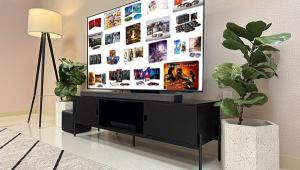Object of Desire Page 4
High-Def DelightsTo check out the 006's high-definition capabilities, I caught the NASCAR Bush Series race on Time Warner Cable. The 70-inch screen really put me in the driver's seat. The colors of the stock-car logos sparkled brilliantly under the Florida sun, and I particularly enjoyed the stop-motion shots of the cars passing out of pit row and over the start line, which let me look through the roll cages and into the interiors. The Sony was so big and revealing that it even disclosed occasional softness or blurring caused by compression in the high-def cable feed.
|
When I looked at the same images (and test patterns) using a component-video connection, I noticed a slight drop in sharpness at 1080i. The Sony could still display eve ry pixel of a 1,920 x 1,080 image, but the most detailed parts looked slightly softer with slightly fainter lines. For that reason alone I recommend using the HDMI input for high-def and an HDMI-equipped DVD player.
It's hard to overstate just how good HDTV looks on the Qualia 006. The detail and hypersharpness in the computer-animated sections of Digital Video Essentials - from the bubbles to the waving grassy objects - was breathtaking, and the live-action sections looked real enough to dive into. This is how high-def was meant to be seen: larger-than life, and finally with all 2 million-plus pixels visible.
Picture PerfectIt's still anyone's guess whether a new generation of 1,920 x 1,080-pixel DLP projectors waiting just around the corner can give SXRD a run for its money. But in the meantime, Sony has made a powerful statement with SXRD, and the Qualia 006 takes a special place in the world. Is the image quality significantly better than any large-screen plasma, single-chip DLP, standard LCD, or LCoS microdisplay I've seen? Yes. Will subsequent, lower-priced SXRD products look as good? Maybe. But whether or not SXRD comes to dominate TVs the way American Idol rules the airwaves, deep-pocketed videophiles will scream in glee like teenage girls - on the inside, at least - when they see the Qualia 006 in person.
In the Lab
Color temperature (Warm color temperature and Pro mode before/after calibration) Low window (20-IRE) ................. 6,780/6,487 K High window (80-IRE) ................ 6,468/6,538 K
Brightness (100-IRE window before/after calibration) 53.3/33.8 ftL
Prior to calibration, the Qualia 006 came close to the standard color temperature of 6,500 K in its Warm preset and Pro picture mode, varying by an average of only 63 K from 20 to 100 IRE. Afterward I got it somewhat closer, using only the user-menu color-temperature controls, achieving an average variation of 22 K. That's the best grayscale tracking I've seen on any microdisplay.
Peak brightness was a bit high for a completely dark environment before calibration but should be fine for moderate ambient light. Viewing angle was better than on any other rear-projection TV I've seen.
Color decoding was excellent, showing no red push and only a 5% error in green with the Wide color space engaged. Edge enhancement was negligible with sharpness reduced to zero. Hotspotting was minor - the best I've seen in a rear-projection set - but still visible in the brighter middle and dimmer edges. Uniformity was slightly worse than DLP, with minor color variations across the screen on gray fields. Only minor geometry errors were visible. The 006 did a mediocre job of maintaining a consistent level of black; after calibration, the PLUGE stripe disappeared on half-gray patterns. Resolution was superior to any other microdisplay I've seen, measuring a full 1,080 lines with any HD feed.













































